| |
|

Monet is recognized to be one of the founders of
Impressionism, and he was the most constant and convinced of all.
Since his beginnings as an artist, he was encouraged to
always listen and transmit his perceptions, and all criticisms which he
had to undergo never did move him away from this search.
Claude Monet was born in Paris on November 14, 1840 but
all his impressions as a child and teenager are related to the city of Le
Havre where his family moved in 1845. There his father held a
trade of colonial articles .
|
|

Self-portrait with a beret
1886

Private Collection
|
 The HEIR to BOUDIN and JONGKIND The HEIR to BOUDIN and JONGKIND
Whereas he was still at college, he gained a certain notoriety
while drawing caricatures which he showed in a store of drawing
supplies with which Eugene Boudin worked at the time.
Finally Boudin convinced the young Monet, at first very reticent, to paint
with him in the open air. Monet will say later: "by the only
example of this artist fond of his art and of his independence, my
destiny as a painter had opened".
His family was not opposed that he became a painter, but his
independent ideas, his criticism of academic painting and his refusal
to follow a good Art School repeatedly caused arguments within his
family. Finally, Monet started to paint in Paris at the Charles Suisse
Academy where he will meet Pissarro in 1859,
and Cézanne in 1861, before having to carry out his
military obligations.
His military service in Algeria (1860-1861) was stopped by a
typhoid which brought him back to France, where he started again to
work in the summer of 1862 in Le Havre with Boudin and the Dutch
landscape-painter Jongkind. He will say speaking of
Jongkind : "...by there completing the teaching which I had received
from Boudin, he was from this moment my true Master,
and it is to him that I owe the final education of my eye".
|
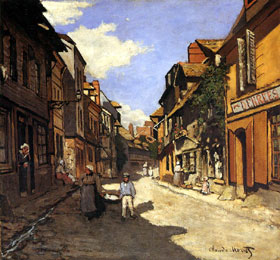
La Bavolle street, Honfleur
1864
Stadische Kunsthalle
Mannheim ,
Germany
|
|
Released by his aunt of the rest of his military
service, he resumed more serious studies at the School of Fine Art of
Paris, and particularly he integrated the Workshop of one of the
professors of the School, Swiss painter Charles Gleyre,
where he was going to bind friendship with Bazille, Renoir
and Sisley .
In the years 1860, these young artists attended the Café
Guerbois, a place where Edouard Manet and Emile Zola often went.
|
 The SALON and the BIRTH OF THE IMPRESSIONIST MOVEMENT The SALON and the BIRTH OF THE IMPRESSIONIST MOVEMENT
The history of Impressionism cannot be dissociated of that of
the Official Salon.
The social, economic and cultural evolution of XIXth century
will have as a consequence that, from now on, art works would be
created mainly by independent artists (rather than by painters at the
service of some prince or corporation).
For these artists, finding possibilities of exhibition was an
existential concern. Although art dealers and their galleries were
going to take an increasing importance, in France, the most important
and impossible to circumvent possibility of exhibition was the Official
"Salon of Paris".
|
From 1863 on, the Salon will be held on an annual basis
and a jury made up of members of the Academy of Fine Arts and of
preceding medal-holders of the Salon will select works to be presented.
For the only year 1863, 4000 works were refused on the 5000 requests
coming from some 3000 artists, which led to the creation in 1863 of the
"Salon des Refusés" (Salon of the Refused ones) .
For Monet and his friends, Renoir, Bazille, Sisley...
years between the "Salon des Refusés" and the War of 1870 were going to
be placed under the sign of an anxious research of their
artistic personality and of a fast alternation of successes
and failures. If they were, except for Cézanne, selected at the Salon
at their first attempt (in 1865 for Monet), they will afterwards
experience frequent refusals.
|
|
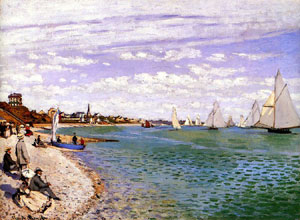
Regattas at Sainte-Adresse
1867
Metropolitan Museum of Art
New York
|
During all this period, these young painters consolidated the
links existing between them and developed new relationships, seeking
for new inspirations and pictorial means. Except for those who had a
comfortable financial situation (Degas, Caillebotte, Bazille), they
will face periods of bitter poverty, and especially Monet - whom
Bazille helped financially - when he had to assume alone his household.
They painted in the open air, in the surroundings of Paris or on the
Norman Coast, where the experiment of the optical phenomena of light
and color which passioned them was more intense
An important crossroads of the evolution of Monet was when he
painted in 1869 with Renoir a series
of paintings in a place of leisures and meeting in Bougival called "the
Grenouillère", very appreciated by the Parisian middle-class,
with bathing, canoeing and a floating restaurant. The paintings which
they made while working with fast and vigorous brushstrokes loaded with
pure color, corresponding to the turbulent animation of the small world
which pressed there, mark the emergence of a new artistic style
dominated by the impression , rather than
details, inaugurating what was going five years later to be called
"Impressionism".
 JOIE DE VIVRE IN SPITE OF POVERTY JOIE DE VIVRE IN SPITE OF POVERTY
|
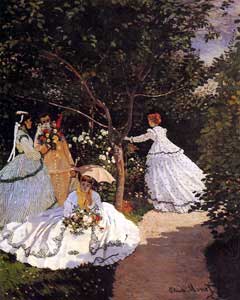
Women in the garden
1867
Musée d'Orsay, Paris
|
|
In 1870, Monet married his model Camille Doncieux,
who had given him his son Jean (1867-1914); in 1878 their second son,
Michel, will be born. Camille posed for many paintings of Monet e.g.
"The walkers", "Women in the garden" (Camille poses for
the 4), "Woman with a parasol", "The Japanese woman",
and many others.
During the Franco-Prussian war of 1870-71 and the short
civil war which followed (the Commune), Monet lived in London and was
presented at Paul Durand-Ruel , an important dealer
of art, who was to contribute greatly to diffuse Impressionist works.
In 1874, in an increasingly hostile atmosphere on behalf
of official circles, Monet and his friends formed a group and exposed
in their own show room for the first time. One of his works,
"Impression, sunrise" gave its name to the Impressionist movement.
|
 IMPRESSIONISM KEYS IMPRESSIONISM KEYS
At the origin, the group of the Impressionists is this small
group of young painters, all aged from thirty to forty years, sharing a
new conception of nature and art. The act of painting and the work of
art which results from it are asserted as a pleasure,
that of the painter and of his personal creation.
In this new conception of art for art, the
truth of a painting is relative because it depends on the subject who
paints it and the spectator who looks at it, and also it is relevant
only at one time and under given conditions, which stresses the
importance of a fast execution, close to a draft.
The intense research of the Impressionists on light and color
effects made them discover new pictorial processes
where the juxtaposition on the canvas of brushstrokes of pure color
will result in a "optical mixture" only in the eye of the spectator.
Working directly from nature, Monet and the other
Impressionists discovered that even the darkest shadows and the
gloomiest days contain an infinite variety of colors. The consequence
of this can be seen in the chromatic vibrancy of
Monet's canvases.
Although Impressionism is essentially an illusionistic
style, the illusion comes from what the artist sees rather
than, as it was the case before, from what he intellectually knows.
Monet eyes perceive nature as a pattern of nameless color patches
without any prevailing conceptual knowledge.
The years which followed saw a rise of the Impressionist
current. Monet took part in the exhibitions of the group of 1874, 1876,
1877, 1879 and 1882.
As William Seitz wrote in 1960, "The landscapes Monet painted
at Argenteuil between 1872 and 1877 are his
best-known, most popular works, and it was during these years that
Impressionism most closely approached a group style.
Here, often working beside Renoir, Sisley, Caillebotte, or Manet, he
painted the sparkling impressions of French river life that so delight
us today."
|
During these years he created many masterpieces such as "Argenteuil
bridge" (1874), "The Saint-Lazare Station" (1877)
and "Street Saint-Denis Festivités of June 30, 1878" .
However his paintings found few purchasers. Desesperately
poor, he would constantly seek for places where life was less
expensive and lived in Argenteuil from 1873 to 1878,
in Vétheuil from 1879 to 1881, in Poissy
in 1882, and Giverny from 1883 until his death.
|
|
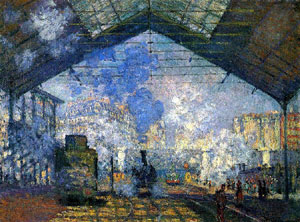
Saint-Lazare station
1877
Musée d'Orsay, Paris
|
Monet lost his wife, Camille, in 1879 ( "Camille Monet
on its bed of death", 1879 ).
 BETTER DAYS BETTER DAYS
By the end of 1880, his works started to draw the attention of
public and critics. Fame brought him comfort and even richness. Monet
then lives in Giverny since 1883 with his two sons, Alice Hoschedé
and her six children. Alice was the woman of the owner of a department
store and collector of Impressionist paintings, Ernest Hoschedé, who
went bankrupt in 1878.
Monet could buy in 1890 the property of Giverny, which he was
hiring, and will marry Alice (deceased in 1911) in 1892, after the
death of her husband.
At that time, the painter was absorbed to paint landscapes in
series : "Rocks of Belle-Ile" (1886), "Cliffs of
Belle-Ile" (1886), "Poplars on banks of Epte" (1890-1891).
|
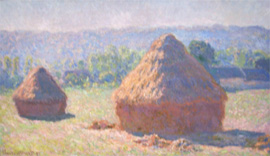
Haystacks at the end of summer,
morning effects
1890
Musée d'Orsay, Paris
|
|
|
Light is always the "principal
character" in Monet' landscapes, and because his purpose was always to
seize a changing effect, he adopted the practice to paint the
same subject under different conditions of light, at various
hours of the day.
He started to paint the series of the haystacks which he
continued over two years. Monet painted them in sunny or gray weather,
in the fog or glazes of snow: "Haystacks, effects of snows,
morning" (1890), "Haystack, end of the summer, morning" (1891),
"Haystack to laying down sun close to Giverny"
(1891).
|
|
The famous series of Monet devoted to the Cathedral
of Rouen under various lights was carried out from the window
of the 2nd floor of a shop opposite the cathedral. He made 18 frontal
views.
Changing canvas according to the light, Monet followed
the hours of the day, from the early morning, with the frontage in
ombré blue of fog, to the afternoon, when the sun, disappearing behind
the city constructions, transformed the stone work eroded by time into
a strange factory of orange and blue: "Rouen Cathedral, the gate
and the Saint-Romain tower at dawn" (1893-1894), "Rouen
Cathedral, the portal and the Saint-Romain tower, full sunlight"
(1894), "The Cathedral of Rouen" (1893-1894), "The
Cathedral of Rouen in the twilight" (1894), "The Cathedral of
Rouen in the evening" (1894)...
|
|
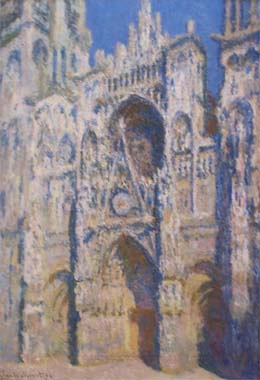
Rouen cathedral,
the portal and the St-Romain
tower, full sunlight.
Blue and gold harmony
1894
Musée d'Orsay
|
 LAST WORKS AT GIVERNY LAST WORKS AT GIVERNY
Monet was to live from 1883 until its death in 1926, that is
to say more than forty years, in his property in Giverny, of which he
will gradually transform the garden in a decorative set.
Monet removes bad grasses and hedges, then digs, sows grass,
plants decorative trees and creates series of various flower beds. He
also produces a kitchen garden to nourish his family. In the evening,
the children often weed and water.
|
|
|
What was in the beginning only a Norman
orchard with only grass and apple trees becomes, with the contribution
of all the family, an historical garden . It is a work of patience,
which Monet continues with love. Even when the task becomes too bigt so
that he cannot assume it alone, he supervises his team of gardeners (1
garden chief and six assistants).
Monet buys seeds and plants everywhere
he goes, concludes exchanges with other gardeners. It is him who
searches the catalogues and places the orders, that they be for seeds,
pots, melon bells...
In 1893, he begins the installation of
his famous "water garden" with the pond with the nymphea.
In 1899, Monet studied for the first time the subject of
the nymphea (species of water lilies): The nymphea white (1899). The
Japanese bridge (1899), Nymphea (1914), (1917), were the principal
topics of its last works.
|
|
|
The Japanese bridge
over the water-lilies pond
at Giverny
1899
Princeton University Art
Museum
New Jersey
|
|
Monet leaves a considerable work as much in
quantity (more than 2000 indexed works), as by his impressionist
research, expression of which he is the most typical
representative. The father of Impressionism will write on this
subject little time before his death:
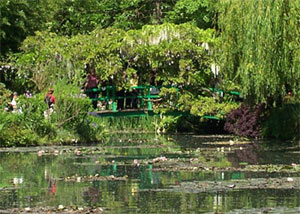
Photo of the japanese bridge
over the water-lilies pond
at Giverny
|
"I always had
horror of theories... I only had the merit to paint directly in front
of nature, trying to translate its most fugitive effects, and I remain
sorry to have been the cause of the name given to a group
of which the majority did not have anything
impressionist"
|

Photo of the garden
and the house of Monet
at Giverny |
Monet's estate at Giverny is
now opened for public visits. It is maintained by the "Claude
Monet Foundation"
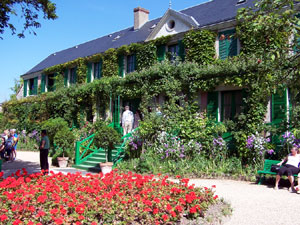
Photo of Monet's house
at Giverny |
Monet bequeathed
to the State fourteen large paintings of his nymphea, which were placed
in 1927, little after his death, in two oval rooms of the Museum of the
Orangery in the Tuileries Garden.
|
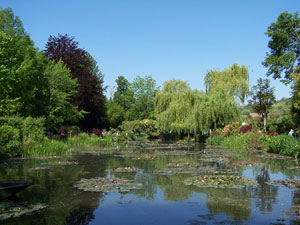
Photo of the water-lilies pond
at Giverny |
|



